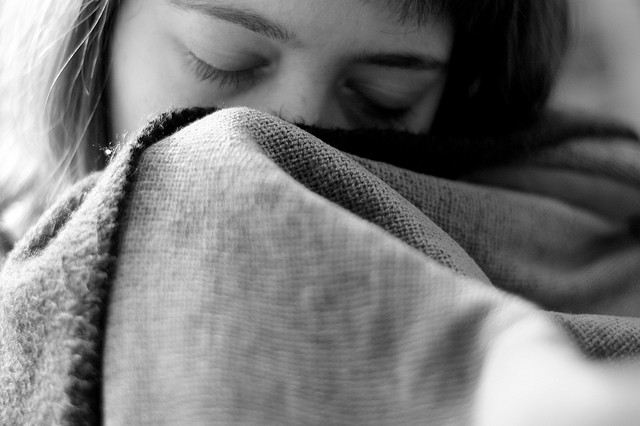Lyme disease is a well-known, but not so well-understood illness that has been getting some attention in the media lately. Celebrities like Yolanda Foster and Avril Lavigne are talking about their personal struggles with it, and the “lyme disease challenge” is starting to make the rounds on the internet. As a “Lymie” myself, I’m hoping to help the healthy layperson understand what this beast of a disease can do to the once-healthy, and hopefully bust any false beliefs you may have about it.
Most people already know that Lyme disease is transmitted by deer ticks found in grassy or wooded areas where deer graze. What you may not have know is that a tick can be the size of a poppy seed (!!!) and that the bullseye rash caused by a lyme-infected tick bite, called erythema migrans, shows up in about 70% of people infected. Early symptoms include joint pain, fatigue, headaches, stiff neck, and sometimes flu-like symptoms; all which look like different ailments. So many people who contract Lyme have the disease for months to years, and bounce from doctor to doctor trying to figure out why they feel so bad before they get a proper diagnosis.
While those suffering unknowingly are seeking out a diagnosis, the borrelia burgdorferi bacteria, a spirochete capable of drilling into tissues and collagen, makes its way into the nervous system and the lymie then begins to deal with crippling fatigue, depression, memory loss, insomnia, tingling sensations, depersonalization, social disorders, anxiety, and Bell’s Palsy. The Lyme-infected persons often look very healthy too, which makes receiving the care and support they need that much more difficult.
I contracted Lyme in 2010 or 2011 and wasn’t diagnosed until 2013. And that’s only because I had googled my symptoms (which ranged from severe fatigue, mood swings, shoulder joint pain, bloating, food allergies, heart palpitations, speech difficulties, the list goes on…) so many times that I marched into my doctor’s office and ordered them to test me for Lyme disease. It isn’t that simple for many, as the tests for Lyme disease can sometimes yield false-negatives. Strangely, it was a relief to have a diagnosis and confirmation that something was indeed wrong, and that I wasn’t just crazy, and that it could be treated. What I didn’t realize at the time was just how long it would be before I felt some degree of healthy again.
Lyme disease treatment can be simple for a recent tick bite. The standard protocol as recommended by the Centers for Disease Control, is a 3-week course of doxycycline, a common broad-spectrum antibiotic. It starts to get complicated if Lyme has been present in a person for more than a few months and lymies can end up being on many different antibiotics for years. Borrelia burgdorferi is a highly intelligent bugger, and is able to evade treatment by encysting and hiding in tissues. It can be difficult to find a doctor that will administer long-term antibiotic treatment, since it’s outside of what the CDC recommends, and patients will spend tens of thousands of dollars on drugs and doctor’s visits since insurance often won’t cover it. In more severe cases of Lyme, patients need a PICC line and intravenous (IV) antibiotics. Many can’t tolerate the long-term antibiotics and look to alternative therapies.
I was initially treated for Lyme disease by an infectious disease specialist who thought that one month of doxycycline would do the trick. It did, but only for the time I was on it, and for about a month afterwards. Then I got sick again. Really sick. I was fatigued beyond anything I’d ever experienced. I was breaking down in tears for no reason. I had an episode at work where I felt like I was going out of my mind and came very close to hurting myself. Since I had been treated and supposedly cured of Lyme, I didn’t think that it was causing my depression. I thought I was under too much stress from work and I ended up seeing a therapist.
Therapy helped, but it wasn’t until 6 months later when I moved back to my home state of California that I found an integrative physician that had cured a family friend of Lyme. I’ve been on antibiotics for 8 months now as well as an herbal protocol, and I’m on the mend. I still have bad days. I have days that I can’t bear to socialize, or that I’m so tired I can’t move or think or even form sentences. The drugs are harsh, and my I might be dealing with side effects for the rest of my life, but I’m far better than I was a year ago, and many previous symptoms, like digestive issues, random food allergies, heart palpitations, and joint pain, have since subsided. I’ve heard that you have to be symptom-free for 2 years before you know that you’re in the clear for Lyme. It might still be a long road, but I know I’m on my way.
I’m not convinced that the medical establishment has a firm grasp on understanding Lyme disease, and that we have a long way to go before there is a cure for it. Some Lyme specialists believe that curing the disease is unlikely, as the bacteria might never fully leave the body, and that it’s a matter of finding a way to live in peace with the organism once the patient is symptom-free. It’s a long road for those of us living with Lyme disease, but hopefully the recent attention will lead us to a better understanding of this epidemic.
Related: Why Me? When a Health Nut Gets Cancer
6 Lessons from Living with Chronic Illness
Photo: Laura Taylor via Flickr





